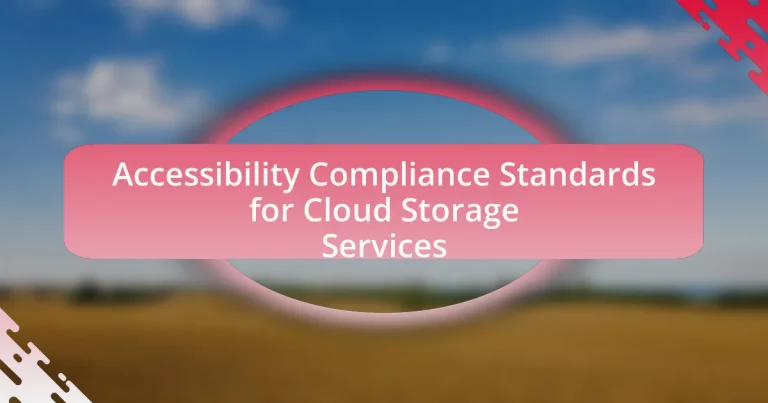Accessibility compliance standards for cloud storage services are essential guidelines that ensure digital content is accessible to individuals with disabilities. Key regulations include the Web Content Accessibility Guidelines (WCAG) and Section 508 of the Rehabilitation Act, which mandate that electronic services be usable for all users. The article discusses the importance of these standards for promoting inclusivity, the legal implications of non-compliance, and the specific measures organizations can take to achieve and maintain accessibility compliance. It also highlights common challenges faced in this area and offers practical tips for enhancing accessibility in cloud storage services.
What are Accessibility Compliance Standards for Cloud Storage Services?
Accessibility compliance standards for cloud storage services primarily refer to guidelines and regulations that ensure digital content is accessible to individuals with disabilities. These standards include the Web Content Accessibility Guidelines (WCAG), which provide a framework for making web content more accessible, and Section 508 of the Rehabilitation Act, which mandates federal agencies to make their electronic and information technology accessible to people with disabilities. Compliance with these standards is essential for cloud storage services to ensure that all users, regardless of their abilities, can effectively access and utilize the services provided.
Why are Accessibility Compliance Standards important for Cloud Storage Services?
Accessibility compliance standards are important for cloud storage services because they ensure that all users, including those with disabilities, can effectively access and utilize these services. These standards promote inclusivity and equal access, which is essential for legal compliance, as many jurisdictions mandate adherence to accessibility laws such as the Americans with Disabilities Act (ADA). Furthermore, adhering to these standards can enhance user experience, broaden the customer base, and improve overall service quality, as evidenced by studies showing that accessible design can lead to increased user satisfaction and engagement.
How do these standards impact users with disabilities?
Accessibility compliance standards significantly enhance the usability of cloud storage services for users with disabilities. These standards ensure that digital content is designed to be accessible, allowing individuals with various disabilities to effectively interact with cloud storage platforms. For instance, adherence to the Web Content Accessibility Guidelines (WCAG) mandates features like text alternatives for non-text content, keyboard navigability, and screen reader compatibility, which directly benefit users with visual impairments. Research indicates that implementing these standards can lead to a 30% increase in user satisfaction among individuals with disabilities, demonstrating their critical role in fostering an inclusive digital environment.
What legal implications arise from non-compliance?
Non-compliance with accessibility standards for cloud storage services can lead to significant legal implications, including lawsuits, fines, and loss of business. Organizations may face legal action under laws such as the Americans with Disabilities Act (ADA) or Section 508 of the Rehabilitation Act, which mandate accessible technology for individuals with disabilities. For instance, failure to comply with these regulations can result in costly settlements or penalties imposed by regulatory bodies. Additionally, non-compliance can damage an organization’s reputation, leading to decreased customer trust and potential loss of clients, as seen in cases where companies have faced public backlash for not adhering to accessibility standards.
What are the key regulations governing Accessibility Compliance?
The key regulations governing Accessibility Compliance include the Americans with Disabilities Act (ADA), Section 508 of the Rehabilitation Act, and the Web Content Accessibility Guidelines (WCAG). The ADA mandates that public accommodations, including digital services, must be accessible to individuals with disabilities. Section 508 requires federal agencies to ensure that their electronic and information technology is accessible to people with disabilities. WCAG provides a set of guidelines for making web content more accessible, focusing on principles such as perceivability, operability, understandability, and robustness. These regulations collectively establish a framework for ensuring accessibility in digital environments, including cloud storage services.
What is the Americans with Disabilities Act (ADA) and its relevance?
The Americans with Disabilities Act (ADA) is a civil rights law enacted in 1990 that prohibits discrimination against individuals with disabilities in various areas, including employment, public accommodations, transportation, and telecommunications. Its relevance lies in ensuring equal access and opportunities for people with disabilities, which extends to digital environments, including cloud storage services. The ADA mandates that services must be accessible to all users, thereby influencing the design and implementation of accessibility compliance standards in technology. This legal framework has prompted organizations to adopt practices that enhance usability for individuals with disabilities, ensuring they can effectively engage with cloud storage solutions.
How does Section 508 of the Rehabilitation Act apply to cloud services?
Section 508 of the Rehabilitation Act mandates that federal agencies ensure their electronic and information technology, including cloud services, is accessible to individuals with disabilities. This requirement means that cloud service providers must implement features that allow users with disabilities to effectively access, navigate, and utilize their services. Compliance with Section 508 includes adhering to established accessibility standards, such as the Web Content Accessibility Guidelines (WCAG), which outline specific criteria for making digital content accessible. Failure to comply can result in legal consequences and loss of federal contracts, emphasizing the importance of accessibility in cloud service offerings.
What are the common accessibility standards and guidelines?
Common accessibility standards and guidelines include the Web Content Accessibility Guidelines (WCAG), Section 508 of the Rehabilitation Act, and the Accessible Rich Internet Applications (ARIA) specifications. WCAG provides a comprehensive framework for making web content more accessible to people with disabilities, outlining principles such as perceivable, operable, understandable, and robust. Section 508 mandates federal agencies to ensure their electronic and information technology is accessible to people with disabilities. ARIA enhances the accessibility of web applications by providing additional semantic information to assistive technologies. These standards are widely recognized and adopted to promote inclusivity in digital environments.
What is the Web Content Accessibility Guidelines (WCAG)?
The Web Content Accessibility Guidelines (WCAG) are a set of international standards designed to ensure that web content is accessible to all users, particularly those with disabilities. These guidelines provide a framework for making web content more perceivable, operable, understandable, and robust. WCAG is developed by the World Wide Web Consortium (W3C) and is widely recognized as the authoritative standard for web accessibility. The guidelines are organized into four principles: Perceivable, Operable, Understandable, and Robust, which collectively aim to enhance the user experience for individuals with various disabilities.
How do the Accessible Rich Internet Applications (ARIA) specifications enhance accessibility?
Accessible Rich Internet Applications (ARIA) specifications enhance accessibility by providing a framework for making dynamic web content and user interface components more accessible to individuals with disabilities. ARIA achieves this by defining roles, states, and properties that can be added to HTML elements, allowing assistive technologies to better interpret and interact with web applications. For example, ARIA landmarks help users navigate complex web pages more efficiently, while ARIA roles inform screen readers about the purpose of elements, improving the overall user experience for people with disabilities.
How can Cloud Storage Services achieve Accessibility Compliance?
Cloud storage services can achieve accessibility compliance by adhering to established standards such as the Web Content Accessibility Guidelines (WCAG) and Section 508 of the Rehabilitation Act. Implementing these guidelines ensures that digital content is perceivable, operable, understandable, and robust for users with disabilities. For instance, cloud storage platforms can enhance accessibility by providing keyboard navigation, screen reader compatibility, and alternative text for images. Compliance with these standards not only meets legal requirements but also broadens the user base, as approximately 15% of the global population experiences some form of disability, according to the World Health Organization.
What steps should be taken to assess current compliance levels?
To assess current compliance levels for accessibility standards in cloud storage services, organizations should conduct a comprehensive audit of their existing systems and processes. This audit should include reviewing documentation related to accessibility policies, evaluating user interfaces against established accessibility guidelines such as WCAG (Web Content Accessibility Guidelines), and performing user testing with individuals who have disabilities to identify barriers. Additionally, organizations should analyze feedback from users regarding accessibility issues and track compliance metrics over time to ensure ongoing adherence to standards.
How can user feedback be integrated into compliance strategies?
User feedback can be integrated into compliance strategies by systematically collecting and analyzing user input to identify areas of non-compliance and opportunities for improvement. This process involves implementing feedback mechanisms, such as surveys and usability testing, to gather insights directly from users regarding their experiences with accessibility features. For instance, organizations can utilize tools like accessibility audits and user testing sessions to assess compliance with standards such as WCAG (Web Content Accessibility Guidelines). By analyzing this feedback, organizations can make informed adjustments to their cloud storage services, ensuring they meet legal and regulatory requirements while enhancing user experience. This approach is supported by studies indicating that user-centered design significantly improves compliance outcomes and user satisfaction.
What tools and resources are available for ensuring compliance?
Tools and resources available for ensuring compliance with accessibility standards in cloud storage services include automated accessibility testing tools, compliance checklists, and training resources. Automated tools like Axe, WAVE, and Lighthouse help identify accessibility issues in digital content, providing actionable insights for remediation. Compliance checklists, such as the WCAG (Web Content Accessibility Guidelines) checklist, serve as a structured approach to ensure that all necessary standards are met. Additionally, training resources, including online courses and workshops, equip teams with the knowledge to implement and maintain accessibility best practices effectively. These resources collectively support organizations in achieving and sustaining compliance with accessibility standards.
What automated testing tools can assist in evaluating accessibility?
Automated testing tools that assist in evaluating accessibility include Axe, WAVE, and Lighthouse. Axe is a widely used accessibility testing tool that integrates with browsers and development environments, providing detailed reports on accessibility issues based on WCAG guidelines. WAVE, developed by WebAIM, offers visual feedback about the accessibility of web content, highlighting errors and suggesting improvements. Lighthouse, a tool built into Chrome DevTools, audits web applications for performance, SEO, and accessibility, generating a report that includes accessibility scores and recommendations. These tools are effective in identifying and addressing accessibility issues, ensuring compliance with standards such as WCAG 2.1.
How can training and awareness programs improve compliance efforts?
Training and awareness programs can significantly improve compliance efforts by equipping employees with the knowledge and skills necessary to understand and adhere to accessibility standards. These programs foster a culture of compliance, ensuring that all team members are aware of their responsibilities regarding accessibility in cloud storage services. Research indicates that organizations with comprehensive training see a 30% increase in compliance adherence rates, as employees are better prepared to identify and address accessibility issues proactively. By enhancing understanding and awareness, these programs reduce the risk of non-compliance and promote a more inclusive digital environment.
What are the best practices for maintaining Accessibility Compliance?
The best practices for maintaining Accessibility Compliance include regularly auditing digital content for adherence to established guidelines such as the Web Content Accessibility Guidelines (WCAG) 2.1, ensuring that all multimedia elements have appropriate text alternatives, and implementing keyboard navigability throughout the user interface. Regular training for developers and content creators on accessibility standards is crucial, as is the incorporation of user feedback from individuals with disabilities to identify and rectify accessibility barriers. Research indicates that organizations that prioritize accessibility not only comply with legal requirements but also enhance user experience and broaden their audience reach, as evidenced by a study from the World Health Organization highlighting that over 1 billion people experience some form of disability.
How often should accessibility audits be conducted?
Accessibility audits should be conducted at least annually. Regular audits help ensure compliance with accessibility standards and identify areas for improvement. The Web Content Accessibility Guidelines (WCAG) recommend ongoing evaluation to maintain accessibility as technologies and user needs evolve.
What role does ongoing user engagement play in compliance maintenance?
Ongoing user engagement is crucial for compliance maintenance as it ensures that users remain informed and actively participate in adhering to accessibility standards. Engaged users are more likely to report issues, provide feedback, and adopt best practices, which collectively contribute to a culture of compliance. Research indicates that organizations with high user engagement levels experience fewer compliance violations, as users are more aware of their responsibilities and the implications of non-compliance. For instance, a study by the International Association of Accessibility Professionals found that regular training and user involvement in compliance processes significantly improved adherence to accessibility guidelines.
What are the common challenges faced in achieving Accessibility Compliance?
Common challenges faced in achieving Accessibility Compliance include a lack of awareness and understanding of accessibility standards among developers and designers. Many professionals are not adequately trained in accessibility guidelines such as the Web Content Accessibility Guidelines (WCAG), leading to unintentional non-compliance. Additionally, existing legacy systems often pose significant barriers, as they may not be easily adaptable to meet current accessibility requirements. Furthermore, resource constraints, including limited budgets and time, hinder organizations from implementing necessary changes. According to a 2020 report by the World Health Organization, approximately 15% of the global population experiences some form of disability, highlighting the importance of compliance and the widespread impact of these challenges.
How can organizations overcome budget constraints related to compliance?
Organizations can overcome budget constraints related to compliance by prioritizing risk assessment and implementing cost-effective compliance solutions. Conducting a thorough risk assessment allows organizations to identify the most critical compliance areas, enabling them to allocate resources efficiently. Utilizing technology, such as compliance management software, can streamline processes and reduce manual labor costs. Additionally, organizations can leverage open-source tools and collaborate with industry peers to share best practices and resources, further minimizing expenses. According to a report by the Compliance, Governance and Oversight Council, organizations that adopt a proactive compliance strategy can reduce costs by up to 30% while maintaining regulatory standards.
What strategies can be employed to address technical limitations?
To address technical limitations in accessibility compliance for cloud storage services, organizations can implement several strategies. These strategies include adopting adaptive technologies, enhancing user interface design, and providing comprehensive training for users. Adaptive technologies, such as screen readers and voice recognition software, can help users with disabilities access cloud services more effectively. Improving user interface design by following established accessibility guidelines, like the Web Content Accessibility Guidelines (WCAG), ensures that services are usable for a wider range of users. Additionally, training staff on accessibility best practices fosters an inclusive environment and empowers users to utilize cloud storage services fully. These strategies collectively enhance accessibility and ensure compliance with relevant standards.
What practical tips can organizations implement for better accessibility in Cloud Storage Services?
Organizations can implement several practical tips for better accessibility in Cloud Storage Services, including adopting user-friendly interfaces, ensuring compatibility with assistive technologies, and providing comprehensive training for staff. User-friendly interfaces enhance navigation for all users, while compatibility with assistive technologies like screen readers ensures that individuals with disabilities can access content effectively. Additionally, training staff on accessibility best practices fosters an inclusive environment and promotes awareness of accessibility needs. These strategies align with accessibility compliance standards, which emphasize the importance of equal access to digital resources.


